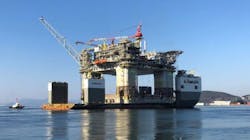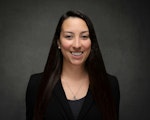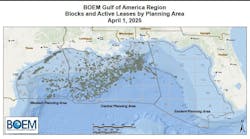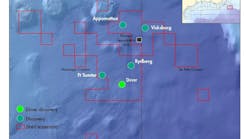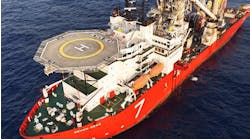OTC 2022: bp keynote focuses on hydrocarbon resiliency and new technology
By Ariana Hurtado
Starlee Sykes, bp’s senior vice president, Gulf of Mexico and Canada, helped kick off the Offshore Technology Conference (OTC) on Monday morning with a confident stance that bp remains dedicated to the Gulf of Mexico (GoM).
In her OTC keynote presentation, “The Role of Resilient Hydrocarbons on the Path to Net Zero: bp’s Perspective from the Gulf of Mexico,” Sykes said oil and gas will continue to play a vital role and that bp has a strong focus to lower its emissions.
“With technology continuous improvement and our analytics and a dedicated focus on reducing our emissions, we’re bringing new production online safely and reliably,” she said. “We’re doing this in a low-carbon way. We’re boosting the energy supply for the U.S and the world. There is no question that bp remains committed to the Gulf.”
Hydrocarbon resiliency
“In the U.S. our hydrocarbon business is a crucial source of U.S. energy security,” Sykes said. “We are an important provider of jobs and investment in the Gulf coast region. We are also an essential driver of bp’s transformation as a company.”
In February 2020 bp announced its intent to reach net zero by 2050 or sooner and help the world do the same. This resulted in bp’s strategy needing to pivot from an international oil company focused on producing resources to an international energy company (IEC) bringing solutions to its customers, Sykes said.
The company’s strategy has three focus areas:
- the resilient hydrocarbon business is a key pillar to bp’s transformation to an IEC;
- low carbon energy; and
- mobility and convenience.
“Where does the Gulf of Mexico fit into the energy transition as an oil and gas business? The answer is clear,” Sykes said. “Our assets in the GoM are continuing to meet resilient oil and gas demand, enhancing global security and setting an example for how to do this responsibly, safely and with lower carbon intensity.”
The GoM produces some of bp’s highest value barrels anywhere in the world, creating a strong infrastructure base, she added. The company currently operates four GoM platforms (Atlantis, Mad Dog, Na Kika and Thunder Horse), and Argos will be the fifth hub.
Argos project updates
A year ago the Argos semisubmersible floating production unit arrived in U.S. waters in Ingleside, Texas, after a 16,000-mile journey from South Korea.
“This is perhaps one of the most exciting highlights we’ll see in the Gulf of Mexico this year,” Sykes said. “As the centerpiece of our $9 billion Mad Dog 2 project, this platform will be our fifth operated hub in GoM and the first platform for bp since Thunder Horse began production 14 years ago in 2008.”
The 60,000-ton platform has a depth the length and width of an American football field.
The bp team is currently working toward startup.
“Domestic energy production is in high demand,” she said. “When fully in place, Mad Dog 2 is set to deliver some of the lowest carbon, highest value barrels from one of the most prolific basins in the world, further strengthening our position for years to come.”
At its peak, Argos is expected to increase capacity by roughly 25% from its 22-well system.
New technologies
bp is also applying digital technologies to make smarter, faster decisions offshore.
“We have improved our production outlook on each of our hubs by doing three things,” she said. “First, leveraging our position as a leader in seismic technology and applying seismic to identify new volumes. [Secondly,] developing infield projects that keep our hubs full by tying in new wells into existing infrastructure. And finally, focusing on system optimization to improve the reliability of our assets.”
The company is evaluating all new technology options for the GoM. A technology bp is currently focused on includes accurate methane measurement so the company can be clear where its emissions come from.
In the GoM’s direct operations, bp’s emissions come from resources (e.g., the rotating equipment used to power its facilities), flaring when there are operational upsets and issues, and from bp’s logistics fleet.
“Looking at how to optimize all of those areas is critical to making improvements,” Skyes said.
In assessing solutions, bp is looking at biofuels for its logistics fleet, electrification options as well as CCS on the Gulf coast.
“One area that is very impactful for us, particularly in the Gulf of Mexico, is seismic,” she added. “Seismic energy, because the complexity of the basin, is critical. Being able to see under the salt and then process that information in a way that gives us a better image, it’s huge.”
bp is also targeting system optimization to understand how it can operate its plants better and understand how fluids flow better. Sykes said this will improve the economics, liability and stability of the company’s operations.
Going back to Argos, Sykes also shared insights about bp’s digital twin technology.
“Engineers in the office can basically see everything about Argos from the office without having to go out in the field,” she said. “So it’s more than a 3D model; it’s got all kinds of data and documentation linked to it.”
So if an engineer wants to design and improve an aspect of the project, they can do so remotely.
“It improves communication between our Houston operators and offshore, and it allows them to be more effective and efficient,” Sykes said. “And we plan to extend that to all of our operations.”
